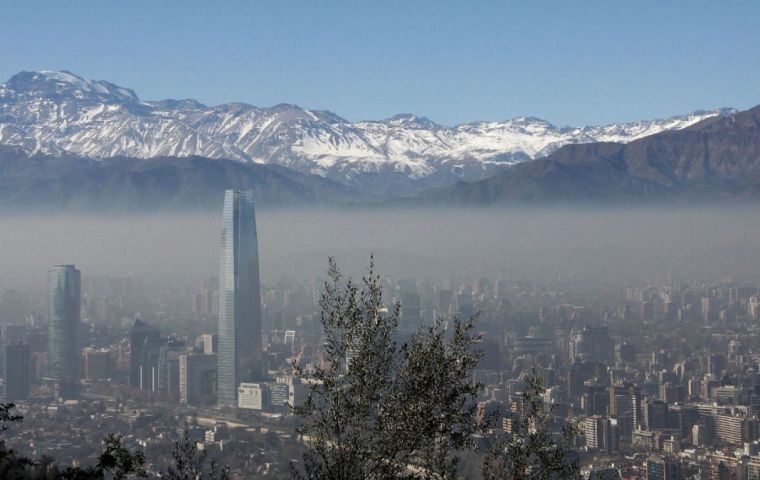MercoPress. South Atlantic News Agency
Smog emergency in Santiago de Chile for the fifth day running
 Besides, home wood stoves and burning farm fields is also banned, and there is a strong recommendation to avoid sports activities in the open, particularly in schools.
Besides, home wood stoves and burning farm fields is also banned, and there is a strong recommendation to avoid sports activities in the open, particularly in schools. Santiago de Chile is under a smog emergency for the fifth day running because of the poor quality of air, as reported by the local authorities of the Chilean capital. For this reason 40% of vehicles without catalytic convertors, and with plate numbers ending in 0,1,2 or 3 are banned from circulating in the city. Likewise motorcycles manufactured before 2002 and with plate numbers ending in 0 and 1.
Besides, home wood stoves and burning farm fields is also banned, and there is a strong recommendation to avoid sports activities in the open, particularly in schools.
At 08:00 Monday morning of Santiago, eight of the monitoring stations reported that air quality was “regular”, with 100/200 micrograms concentrations of toxic particles per cubic meter. However in the more posh quarters of the city, Las Condes, La Florida y Puente Alto, the level was described as “good”, with less than 100 micrograms of toxic particles.
However on Sunday the monitoring station at Los Cerrillos, southeast of Santiago reported 302 micrograms per cubic meter of toxic particles, which is equivalent to a pre emergency situation.
The Chilean capital with seven million people is encased in a valley surrounded by mountains, and during autumn and winter months air quality worsens because of the absence of any breeze to disseminate the toxic particles, as well as the thermal inversion phenomenon.
This phenomenon means that surface temperature is lower than higher up, and thus particles remain at soil level. Monday's emergency alert is the eighth so far in 2018 since last 12 May.




Top Comments
Disclaimer & comment rules-

-

-

Read all comments“ ...motorcycles manufactured before 2002 ....”
May 30th, 2018 - 11:21 pm 0Further evidence of the corruption in Chile.
An intelligent approach to the matter of emissions would be on the basis of not the year of manufacture, but on the basis of the actual annually measured amount that each motorcycle or other vehicle actually puts out. The annual Revisión Técnica process provides the government with hard emissions data on every on every vehicle that is registered for street use. But in this case, the new-vehicle distributors -- which have connived with the legislature to prevent the import of used vehicles in most of the country -- are now finding ways to accelerate the obsolescence of even verifiably low-emissions vehicles in order to increase their new-vehicle sales. (A number of pre-2002 models with EFI and catalyst systems offer exceptionally low emissions).
Truly corrupt, and very chileno, po.
Or maybe it's just easier to enforce, assuming Chilean number plates give the year like UK ones do. Much simpler to spot number plates dated pre-2002 than to give the police a long list of makes and models to look out for, especially when they will be looking at the plates anyway for those ending in 0 or 1.
May 31st, 2018 - 12:20 am 0No, tree, the plates do not change with stickers from year to year. A plate issued in year 2000 looks just like a plate issued in 2018.
May 31st, 2018 - 03:09 pm 0There is no way to glance at a number plate to tell what year the vehicle is or even if the registration is current.
The restriction is a simple matter of corruption, with a dash of technological stupidity, on the part of the legislature.
Commenting for this story is now closed.
If you have a Facebook account, become a fan and comment on our Facebook Page!